Marlow Kelly's Blog, page 31
April 19, 2014
Theodora - From Prostitute to Empress
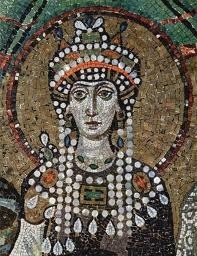 Empress Theodora How could a woman go from being prostitute to empress? Believe it or not the answer is – love. But I’ll get to that later. First let me tell you about Theodora’s early life.
Empress Theodora How could a woman go from being prostitute to empress? Believe it or not the answer is – love. But I’ll get to that later. First let me tell you about Theodora’s early life. She was born around 500AD, into a world where the old Roman Empire was in the process of dying, giving birth to the new Byzantine Empire. No one knows the exact date or her birth which is not surprising when you consider her humble origins. Her father was a bear trainer in the Constantinople Hippodrome and her mother was a dancer. Her father died when she was still a child, forcing her and her sisters to become dancers and actresses too. In this world an actress was the equivalent of a prostitute. Theodora would dance for the nobles and then entertain them in private. We don’t know the exact age she started this profession, but I do know that by today’s standards she was way too young.
At the age of sixteen, she became the escort to a wealthy man named Hecebolus. By all accounts she was beautiful, witty, and intelligent. When he was appointed to the position of governor to the minor North African province of Pentapolis, she accompanied him. We don’t know exactly what happened in their relationship, but after four years Hecebolus threw her out of his house, penniless. This had to have been a low point for Theodora. She was in a foreign land, far from home, with nothing but the clothes on her back. Once again, she was forced to rely on her looks and charm to provide an income. She travelled through the Middle East making her way back to Constantinople.
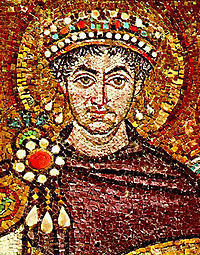 Justinian I Now this is where the records become a little shaky. Some sources say she was in Antioch others say Alexandria, Alexandria, at that time, was the capital of Egypt. Wherever it happened at some point in her early twenties Theodora met Pope Timothy, the thirty-second pope of the Eastern Church. She converted to Monophysite Christianity. This is a form of Christianity that was considered heretical in Constantinople. She renounced her previous life as a courtesan, and returned to Constantinople in 522AD, making her living spinning wool. It was here that she met Justinian and fell in love.
Justinian I Now this is where the records become a little shaky. Some sources say she was in Antioch others say Alexandria, Alexandria, at that time, was the capital of Egypt. Wherever it happened at some point in her early twenties Theodora met Pope Timothy, the thirty-second pope of the Eastern Church. She converted to Monophysite Christianity. This is a form of Christianity that was considered heretical in Constantinople. She renounced her previous life as a courtesan, and returned to Constantinople in 522AD, making her living spinning wool. It was here that she met Justinian and fell in love.I should mention this is not as surprising at it might seem at first glance. Justinian wasn’t emperor yet, but he was heir to the throne. And he had also been born into poverty. It was Justinian’s uncle, Justin I, who as an illiterate soldier worked his way to the position of emperor. Justin took Justinian under his wing, educated him, and named him heir. So Justinian probably understood, all too well, the circumstances that had forced Theodora to become a courtesan.
The biggest obstacle standing in their way was a law forbidding a high-class official such as Justinian from marrying a low class courtesan. Justin I changed this law and the couple were married in 525AD. Justinian became emperor in 527AD following the death of his uncle. Theodora ruled alongside him. I don’t think it was that she revelled in the power. I think she was a good judge of character, astute and Justinian knew he could always count of her to have his best interests at heart.
In 532 AD when anger over high taxes, religion, and political corruption caused a riot, Justinian was advised by his officials to leave the city. It was Theodora who counselled him to remain and quell the uprising. He took her advice and successfully crushed the revolt.
In her time as empress she championed women’s causes passing laws that prohibited forced prostitution. She also expanded the rights of women in divorce and property ownership, gave mothers guardianship rights over their children, forbade the killing of a wife who had committed adultery, stopped the killing of unwanted infants by exposure, and instituted the death penalty for rape. She also closed brothels and created convents where ex-prostitutes could support themselves by other means.
Together with Justinian, she restored the empire gaining back some of the territories lost to the Germanic tribes in the West. They also built bridges, aqueducts, and churches, including Hagia Sophia which is still standing today.
 Hagia Sophia Theodora died in 548AD of cancer. Justinian never remarried, dying seventeen years later in 565 AD.
Hagia Sophia Theodora died in 548AD of cancer. Justinian never remarried, dying seventeen years later in 565 AD. Not everyone loved Justinian and Theodora. The couple most certainly had their detractors, but even those who hated Theodora never accused her of immoral behaviour, or of not supporting her husband. Personally, I like the fact that she used her power to help women and children, changing laws to make their lives better. She was a woman who squeezed her lemons into lemonade and for that she is an excellent example for us all.
 Justinian and His Retinue. This mosaic, executed in 547, sits in the Basilica of San Vitale, Ravenna, Italy
Justinian and His Retinue. This mosaic, executed in 547, sits in the Basilica of San Vitale, Ravenna, Italy
Published on April 19, 2014 06:46
April 12, 2014
Grace O'Malley Ireland's Pirate Queen
Grace O’Malley (Gráinne Ní Mháille in Irish Gaelic) was born into a noble family in 1530 in Co. Mayo, Ireland. It is believed her father taught her how to sail and conduct business as a young girl. Words used to describe her include: trader, pirate, chieftain, and the English considered her a traitor. It’s interesting to me that most of what we know about Grace comes from English writings and not Irish sources. If I find out why she was ignored by her own people, I’ll let you know.
At the age of sixteen Grace married her first husband Donal O’Flaherty by whom she had three children, two boys and a girl. It is believed to have been a politically motivated marriage, but they stayed together for nineteen years, until his death.
Sources differ on what happened next, some say she assumed leadership of the his clan on her son’s behalf, and others say the O’Flaherty’s refused to give her what she was due on her husband’s death. Under Brehon law (The Irish had their own system of laws that governed every part of their life.) any property she held when she entered the marriage would have stayed in her possession. She would also have been entitled to half of any profits they made while married.
Whatever the truth, it seems that Grace returned to the O’Malley clan in 1564. This is when she starts her life as an independent woman. With a base of operations on Clare Island, she earned a living using her father’s ships, and a private army of two hundred men. She traded, and demanded taxes from ships in her waters; this is where the piracy comes in. She was known for being an able sailor and commanded her ships in person.
In 1566 she married for the second time to Richard Burke (Also known as Iron Richard Bourke.) This was a trial marriage for one year. A trial marriage was another Irish tradition. A couple would marry for one year at the end of which they could decide whether to stay married or not. Grace moved her men and ships to Rockfleet Castle on Achill Island. It is believed, she then divorced Richard. But they must have been fond of each other because they stayed close until his death in 1583. By Richard, she had one son, Theobald. It is rumoured, she gave birth to him aboard one of her ships.
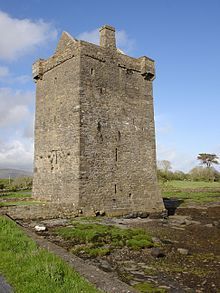 Rockfleet Castle Now, this was a time when the English were forcing their way across Ireland, compelling the old Gaelic noble families to submit to English rule. At the heart of the matter is the English Crown’s insistence that the Irish adopt the English rule of succession, meaning that a title would automatically go to the eldest son. In the Irish clan system a vote was taken to choose the chief from the nobility of the clan. By ending the Irish vote of succession the English cheated Richard out of his leadership of the Mac William clan. Richard and Grace unite, supporting each other against their common enemy, resisting English rule over their lands. When Richard dies in 1583 she returns to her power base at Rockfleet Castle.
Rockfleet Castle Now, this was a time when the English were forcing their way across Ireland, compelling the old Gaelic noble families to submit to English rule. At the heart of the matter is the English Crown’s insistence that the Irish adopt the English rule of succession, meaning that a title would automatically go to the eldest son. In the Irish clan system a vote was taken to choose the chief from the nobility of the clan. By ending the Irish vote of succession the English cheated Richard out of his leadership of the Mac William clan. Richard and Grace unite, supporting each other against their common enemy, resisting English rule over their lands. When Richard dies in 1583 she returns to her power base at Rockfleet Castle.
In 1584 Sir Richard Bingham is appointed English Governor. Bingham’s job is to subdue the Irish population. Grace resisted using her fleet to raid coastal towns, and disrupt English trade. She also carried supplies and troops for the rebels. Bingham seems to have really hated Grace, claiming she was "nurse to all rebellions in the province for this forty years." Pretending to want to negotiate a truce, Bingham finally captures her in 1586. He condemns her to death. She is saved when her son-in-law offers himself as a hostage. Grace continues to seek support for her cause, consulting with the O’Neill and the O’Donell clans in Ulster, who in turn, are seeking help from the King of Spain. Bingham reports Grace to Queen Elizabeth I, accusing her of treason.
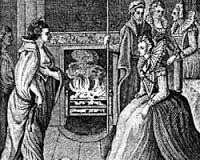 Grace O'Malley and Queen Elizabeth I Bingham continues to provoke Grace, stealing her possessions and ships. Grace writes to the Queen appealing for justice. In 1593 Bingham captures her son and charges him with treason, a charge punishable by death. Grace takes a gamble and journeys to England to meet with Queen Elizabeth at Greenwich.She was now sixty-three years old and showed no signs of slowing down.
Grace O'Malley and Queen Elizabeth I Bingham continues to provoke Grace, stealing her possessions and ships. Grace writes to the Queen appealing for justice. In 1593 Bingham captures her son and charges him with treason, a charge punishable by death. Grace takes a gamble and journeys to England to meet with Queen Elizabeth at Greenwich.She was now sixty-three years old and showed no signs of slowing down.
Grace promises to fight the Queens’s enemy’s, if her ships and livelihood are returned. Elizabeth in turn has a great deal of compassion for Grace describing her as this aged woman. Perhaps Elizabeth finds in Grace a kindred spirit, because the Queen releases Grace’s son.
click here to learn more about their meeting Bingham is recalled to England the following year. Grace returns to Ireland and her way of life, dying of what appears to be natural causes in 1603.
Nowadays, Grace O’Malley she is seen as an Irish hero and rebel. She was born into a time of great upheaval. The old Irish way and the Brehon system of laws were being eradicated by the English. Did she see herself as a rebel, a role model for women and Irish resistance? I don’t know, but her actions seem to indicate that she saw herself first and foremost as a mother, and leader. And like all good leaders she did what was necessary to continue her way of life. Whether it be raiding or negotiating with a queen. She was a strong woman and an excellent example to us all. Every May there is a festival, in Clew bay, Co. Mayo, to honour her life. I wish I could be there.

At the age of sixteen Grace married her first husband Donal O’Flaherty by whom she had three children, two boys and a girl. It is believed to have been a politically motivated marriage, but they stayed together for nineteen years, until his death.
Sources differ on what happened next, some say she assumed leadership of the his clan on her son’s behalf, and others say the O’Flaherty’s refused to give her what she was due on her husband’s death. Under Brehon law (The Irish had their own system of laws that governed every part of their life.) any property she held when she entered the marriage would have stayed in her possession. She would also have been entitled to half of any profits they made while married.
Whatever the truth, it seems that Grace returned to the O’Malley clan in 1564. This is when she starts her life as an independent woman. With a base of operations on Clare Island, she earned a living using her father’s ships, and a private army of two hundred men. She traded, and demanded taxes from ships in her waters; this is where the piracy comes in. She was known for being an able sailor and commanded her ships in person.
In 1566 she married for the second time to Richard Burke (Also known as Iron Richard Bourke.) This was a trial marriage for one year. A trial marriage was another Irish tradition. A couple would marry for one year at the end of which they could decide whether to stay married or not. Grace moved her men and ships to Rockfleet Castle on Achill Island. It is believed, she then divorced Richard. But they must have been fond of each other because they stayed close until his death in 1583. By Richard, she had one son, Theobald. It is rumoured, she gave birth to him aboard one of her ships.
 Rockfleet Castle Now, this was a time when the English were forcing their way across Ireland, compelling the old Gaelic noble families to submit to English rule. At the heart of the matter is the English Crown’s insistence that the Irish adopt the English rule of succession, meaning that a title would automatically go to the eldest son. In the Irish clan system a vote was taken to choose the chief from the nobility of the clan. By ending the Irish vote of succession the English cheated Richard out of his leadership of the Mac William clan. Richard and Grace unite, supporting each other against their common enemy, resisting English rule over their lands. When Richard dies in 1583 she returns to her power base at Rockfleet Castle.
Rockfleet Castle Now, this was a time when the English were forcing their way across Ireland, compelling the old Gaelic noble families to submit to English rule. At the heart of the matter is the English Crown’s insistence that the Irish adopt the English rule of succession, meaning that a title would automatically go to the eldest son. In the Irish clan system a vote was taken to choose the chief from the nobility of the clan. By ending the Irish vote of succession the English cheated Richard out of his leadership of the Mac William clan. Richard and Grace unite, supporting each other against their common enemy, resisting English rule over their lands. When Richard dies in 1583 she returns to her power base at Rockfleet Castle.In 1584 Sir Richard Bingham is appointed English Governor. Bingham’s job is to subdue the Irish population. Grace resisted using her fleet to raid coastal towns, and disrupt English trade. She also carried supplies and troops for the rebels. Bingham seems to have really hated Grace, claiming she was "nurse to all rebellions in the province for this forty years." Pretending to want to negotiate a truce, Bingham finally captures her in 1586. He condemns her to death. She is saved when her son-in-law offers himself as a hostage. Grace continues to seek support for her cause, consulting with the O’Neill and the O’Donell clans in Ulster, who in turn, are seeking help from the King of Spain. Bingham reports Grace to Queen Elizabeth I, accusing her of treason.
 Grace O'Malley and Queen Elizabeth I Bingham continues to provoke Grace, stealing her possessions and ships. Grace writes to the Queen appealing for justice. In 1593 Bingham captures her son and charges him with treason, a charge punishable by death. Grace takes a gamble and journeys to England to meet with Queen Elizabeth at Greenwich.She was now sixty-three years old and showed no signs of slowing down.
Grace O'Malley and Queen Elizabeth I Bingham continues to provoke Grace, stealing her possessions and ships. Grace writes to the Queen appealing for justice. In 1593 Bingham captures her son and charges him with treason, a charge punishable by death. Grace takes a gamble and journeys to England to meet with Queen Elizabeth at Greenwich.She was now sixty-three years old and showed no signs of slowing down.Grace promises to fight the Queens’s enemy’s, if her ships and livelihood are returned. Elizabeth in turn has a great deal of compassion for Grace describing her as this aged woman. Perhaps Elizabeth finds in Grace a kindred spirit, because the Queen releases Grace’s son.
click here to learn more about their meeting Bingham is recalled to England the following year. Grace returns to Ireland and her way of life, dying of what appears to be natural causes in 1603.
Nowadays, Grace O’Malley she is seen as an Irish hero and rebel. She was born into a time of great upheaval. The old Irish way and the Brehon system of laws were being eradicated by the English. Did she see herself as a rebel, a role model for women and Irish resistance? I don’t know, but her actions seem to indicate that she saw herself first and foremost as a mother, and leader. And like all good leaders she did what was necessary to continue her way of life. Whether it be raiding or negotiating with a queen. She was a strong woman and an excellent example to us all. Every May there is a festival, in Clew bay, Co. Mayo, to honour her life. I wish I could be there.

Published on April 12, 2014 05:29
April 5, 2014
Medieval Women Warriors
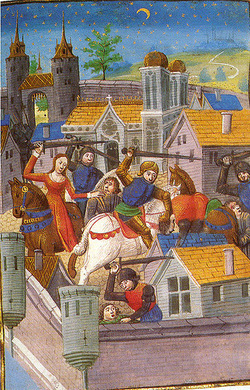 A mounted woman wielding a sword
A mounted woman wielding a sword March 2014 was Women’s History Month in the United States and March 8th 2014 marked International Women’s day, so this is a tad tardy, but I wanted to write something to commemorate all the brave and courageous women that have fought as warriors in a man’s world. The medieval era was one where war was commonplace, so there are countless examples where women were forced to defend their people and their homes. I thought I would introduce some of them to you in this post.
Matilda of Tuscany 1046 – 1115
Matilda was an Italian noblewoman who was renowned for her military strategy in defense of the Pope Gregory VII
The Order of the Hatchet
This was a military order of knighthood for women. It was formed in 1149 by Raymond Bergenger, Count of Barcelona, to honour the women of the town of Tortosa who took up arms to defend the town against a Moor attack. They fought with anything at hand, including hatchets.
Nicola de la Haye
In 1217 Nicola, Constable of Lincoln, held Lincoln Castle against the French forces for one month until help could arrive. She was in her sixties at the time.
Christina Bruce
In 1335 Christina defended Kildrummy Castle from an English attack, led by David Strathbogie, until her husband, Andrew Murray, could come to her aid.
Agnes Randolph – Countess of Dunbar
In 1338 Agnes held Dunbar castle against a five-month siege by the English. She succeeded in utterly defeating and demoralising her enemy. My post on 14th December 2013 goes into more detail.
Joanne De Montfort also known as Joanne of Flanders
In the siege of Hennebont, in 1342, she dressed in armour and led raids, protecting the town in the name of her infant son.
Joan of Arc 1412 – 1431
No blog on medieval women warriors would be complete without mentioning Joan of Arc. She led the French forces against the English and was responsible for their victory and the coronation of King Charles VII. Captured by the English, she was tried for heresy, not as a witch as some believe. The main charges against her seem to stem from her wearing men’s clothing. But the Catholic Church dictated that women were allowed to wear men’s clothes in order to protect themselves. Joan was justified in wearing her suit of armour on the battlefield. In May 1431 she was executed by burning. She was so influential and inspiring that the English destroyed her body and dumped it in the River Seine, so no relics could be collected.
Margaret of Anjou 1430 - 1482
Her husband, Henry VI of England, was prone to frequent bouts of insanity, so Margaret ruled the kingdom in his place. By all accounts she was not a very nice person. Leader of the Lancastrian faction in the War of the Roses, she led several battles against the Yorkists before ultimately being defeated.
This list is by no means complete. It seems that the average medieval noble woman was expected to defend her home and that instruction in the martial arts was not as limited as you might expect, as shown in this illustration from the Walpurgis Fechtbuch – a fourteenth century German training manual. If there is an historical woman warrior that has sparked your interest I would love to hear about her.
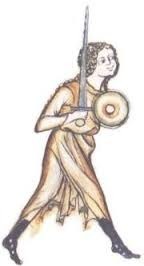 A woman training with a sword from the Walpurgis Fechtbuch
A woman training with a sword from the Walpurgis Fechtbuch
Published on April 05, 2014 06:32
March 29, 2014
An Interview with Author Lori Power
I managed to catch up with author Lori Power this week. She graciously agreed to answer five questions about her debut novel Storm of Passion.
1. I know that you grew up in a small fishing town in Nova Scotia and have to wonder how much of your book, Storms of Passion, is based on fact, or was created by your amazing imagination. In your book the MacLean family run an adventure sailing school where they teach vacationers how to sail. Do such holidays exist or did you invent them?
A lot of Storms of Passion is based on fact. The storm did exist. People did perish while others who were tossed out to the sea did survive. Their survival was based on the skills and tenacity of Coast Guard personnel. Who risked everything to save them. The fact that they do this every day is a marvel to me.
Storms of Passion took shape while I was on Prince Edward Island, where I spent a week in an excellent small community on the far Northern tip, I couldn’t even get cell coverage. The scenery, the sights, the smells were all from this small community. I sat on the red sand and watched sailing boats glide by and wished I could learn to master such a craft and feel the ocean air.
My knowledge of small town life came from my experiences growing up in such a town.
Learn to Sail Adventure vacations do exist on both coasts. There is also an excellent program for Grade 12 students to finish their final year at sea while learning the trade of sailing. Wouldn’t that be exciting?
2. Your hero, Tuck, is such a great character. He’s a computer whiz, a rescue swimmer with the coast guard, and a cute hunk. Are there really rescue swimmers with the coast guard? And if so, did you know any growing up?
Rescue swimmers are an integral part of the Coast Guard personnel. I had an opportunity while living in Prince George to meet and interview some rescue swimmers. Two things there: guys in uniform – wow. Guys in uniform with a fully toned body, complete with a six-pack underneath, clearly visible through their uniform – ouch!
3. I love Vivian, your heroine. She’s an intelligent, tall green-eyed beauty with just a touch of self-doubt. Where did the inspiration for Vivian come from?
My lifelong best friend from back home. I won’t say her name and embarrass her, but I am sure when she reads the story, she recognized herself.
4. When I read your book I was struck by the amount of nautical knowledge you possess. Did you learn this growing up or did you have to do a lot of research?
I did some basic research. My dad was a sailor for many years and has shared lots of stories. I am also fortunate my husband’s uncle, who was a sailor of a small masted boat, took me through some stories and adventures – near misses – he had at sea, sailing from Nova Scotia to the Caribbean, and events he experienced crossing the open Atlantic to Newfoundland.
5. The ferocious storm that threatens Vivian’s life, (I don’t want to give anything away here, but it was so gripping.) was brutal. Have you ever been at sea in a hurricane? I ask because your descriptions are so real.
The storm was a real event. All action from Vivian in the storm is strictly a figment of my imagination. Nova Scotia is constantly bombarded with storms jutting out as it does into the Atlantic, so it isn’t a stretch for me to ‘imagine’ what it would be like. Some events that Vivian goes through during the storm are based on events my Dad experienced at sea.
Click here to purchase Storms of passion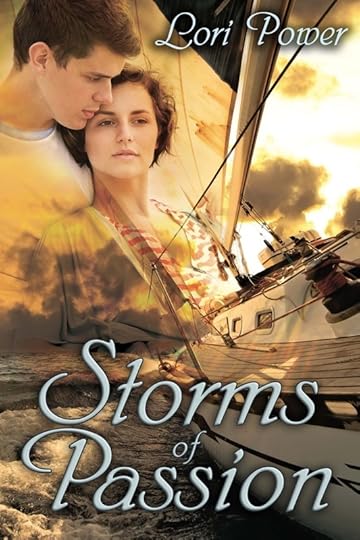
1. I know that you grew up in a small fishing town in Nova Scotia and have to wonder how much of your book, Storms of Passion, is based on fact, or was created by your amazing imagination. In your book the MacLean family run an adventure sailing school where they teach vacationers how to sail. Do such holidays exist or did you invent them?
A lot of Storms of Passion is based on fact. The storm did exist. People did perish while others who were tossed out to the sea did survive. Their survival was based on the skills and tenacity of Coast Guard personnel. Who risked everything to save them. The fact that they do this every day is a marvel to me.
Storms of Passion took shape while I was on Prince Edward Island, where I spent a week in an excellent small community on the far Northern tip, I couldn’t even get cell coverage. The scenery, the sights, the smells were all from this small community. I sat on the red sand and watched sailing boats glide by and wished I could learn to master such a craft and feel the ocean air.
My knowledge of small town life came from my experiences growing up in such a town.
Learn to Sail Adventure vacations do exist on both coasts. There is also an excellent program for Grade 12 students to finish their final year at sea while learning the trade of sailing. Wouldn’t that be exciting?
2. Your hero, Tuck, is such a great character. He’s a computer whiz, a rescue swimmer with the coast guard, and a cute hunk. Are there really rescue swimmers with the coast guard? And if so, did you know any growing up?
Rescue swimmers are an integral part of the Coast Guard personnel. I had an opportunity while living in Prince George to meet and interview some rescue swimmers. Two things there: guys in uniform – wow. Guys in uniform with a fully toned body, complete with a six-pack underneath, clearly visible through their uniform – ouch!
3. I love Vivian, your heroine. She’s an intelligent, tall green-eyed beauty with just a touch of self-doubt. Where did the inspiration for Vivian come from?
My lifelong best friend from back home. I won’t say her name and embarrass her, but I am sure when she reads the story, she recognized herself.
4. When I read your book I was struck by the amount of nautical knowledge you possess. Did you learn this growing up or did you have to do a lot of research?
I did some basic research. My dad was a sailor for many years and has shared lots of stories. I am also fortunate my husband’s uncle, who was a sailor of a small masted boat, took me through some stories and adventures – near misses – he had at sea, sailing from Nova Scotia to the Caribbean, and events he experienced crossing the open Atlantic to Newfoundland.
5. The ferocious storm that threatens Vivian’s life, (I don’t want to give anything away here, but it was so gripping.) was brutal. Have you ever been at sea in a hurricane? I ask because your descriptions are so real.
The storm was a real event. All action from Vivian in the storm is strictly a figment of my imagination. Nova Scotia is constantly bombarded with storms jutting out as it does into the Atlantic, so it isn’t a stretch for me to ‘imagine’ what it would be like. Some events that Vivian goes through during the storm are based on events my Dad experienced at sea.
Click here to purchase Storms of passion

Published on March 29, 2014 07:30
March 24, 2014
Meet Lori Power
I asked Lori four questions here are her answers.
What are you working on?
As an author, I am always envisioning new stories. I will drive somewhere, see a client or listen to the radio and something will spark my imagination. It’s an ah-ha moment where I think, ‘wow, I can use that.’ Then the process starts where I picture that moment with a particular style of character and I’m off on an adventurous quest.
How does your work differ from others of its genre?
At the moment I am finishing a Young Adult love story entitled Chrysalis. What makes this different than my first novel, Storms of Passion, which was a romance, is Chrysalis is a love story. To my mind a love story is an in-depth look at characters who have gone beyond the initial spark of attraction, the situations of romancing the person you want to bed, to the point where the they are willing to work to build a relationship, overcome adversity and grow together.
Why do you write what you do?
I write what I want to read. If I wouldn’t read it, I won’t write it. I love a good adventure and I believe my work differs from others based on the life experiences I inject into stories. Not only can I envision the moments, see the sights and smells, but because I’ve been there, I write what I know, where I’ve been and how I and others have reacted to the situation.
How does your writing process work?
As a business owner of a national company, I have been able to travel from one coast to the other, experience how people live, work and prosper in the various, often remote areas of this significantly diverse country. As a mother and wife, I understand the fear and protective nature associated with those roles and I am lucky enough to be married to a ‘considerate lover’ who tries very hard to be a redneck, though at the heart of the matter, he is the one who taught me how to be romantic and face adversity as a team member.
Please be sure to connect with my fellow authors:
Diana Cranstoun
www.dianacranstoun.com
Dee Van Dyk
www.deevandyk.wordpress.com
Lori Power is the owner of Quikcard Benefits Consulting Inc., a national brokerage firm.The mother of two boys and wife for more years than she wishes to admit, for it only ages her. Lori Power has dreamed of being a writer since she was a teenager and is very proud of her first published novel, Storms of Passion, set for its worldwide release through Wild Rose Press, on March 27th.
To learn more about Lori's book read my blog on Saturday 29th March as I interview her about her latest release Storms of Passion.
Click here to visit lori's website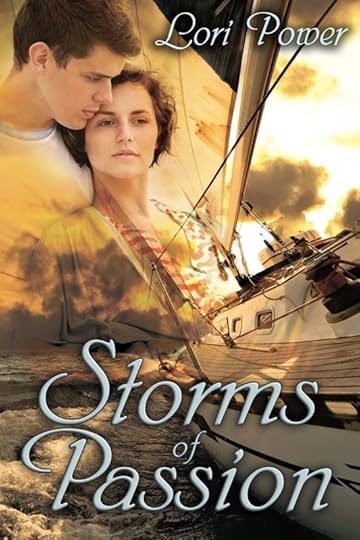
What are you working on?
As an author, I am always envisioning new stories. I will drive somewhere, see a client or listen to the radio and something will spark my imagination. It’s an ah-ha moment where I think, ‘wow, I can use that.’ Then the process starts where I picture that moment with a particular style of character and I’m off on an adventurous quest.
How does your work differ from others of its genre?
At the moment I am finishing a Young Adult love story entitled Chrysalis. What makes this different than my first novel, Storms of Passion, which was a romance, is Chrysalis is a love story. To my mind a love story is an in-depth look at characters who have gone beyond the initial spark of attraction, the situations of romancing the person you want to bed, to the point where the they are willing to work to build a relationship, overcome adversity and grow together.
Why do you write what you do?
I write what I want to read. If I wouldn’t read it, I won’t write it. I love a good adventure and I believe my work differs from others based on the life experiences I inject into stories. Not only can I envision the moments, see the sights and smells, but because I’ve been there, I write what I know, where I’ve been and how I and others have reacted to the situation.
How does your writing process work?
As a business owner of a national company, I have been able to travel from one coast to the other, experience how people live, work and prosper in the various, often remote areas of this significantly diverse country. As a mother and wife, I understand the fear and protective nature associated with those roles and I am lucky enough to be married to a ‘considerate lover’ who tries very hard to be a redneck, though at the heart of the matter, he is the one who taught me how to be romantic and face adversity as a team member.
Please be sure to connect with my fellow authors:
Diana Cranstoun
www.dianacranstoun.com
Dee Van Dyk
www.deevandyk.wordpress.com
Lori Power is the owner of Quikcard Benefits Consulting Inc., a national brokerage firm.The mother of two boys and wife for more years than she wishes to admit, for it only ages her. Lori Power has dreamed of being a writer since she was a teenager and is very proud of her first published novel, Storms of Passion, set for its worldwide release through Wild Rose Press, on March 27th.
To learn more about Lori's book read my blog on Saturday 29th March as I interview her about her latest release Storms of Passion.
Click here to visit lori's website

Published on March 24, 2014 08:10
March 22, 2014
Was There a Female Pope?
This week’s blog was inspired by a friend who told me about the female pope. As a religious leader in her community she had attended a presentation on the subject of Pope Joan. I grew up in the catholic church and was surprised that I had never heard of her. Could this be true? Had there really been a woman pope in the middle ages? For those of you unfamiliar with the story of her life I’ll give you the short version.
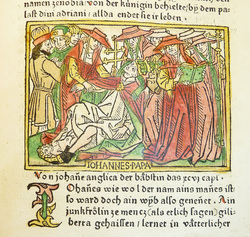 A Woodcut of Pope Joan giving birth Pope Joan reigned around 855 AD as Pope John VIII. Some say she reigned for two weeks others say two years. When told as a twelve year old that she would be unable to continue her studies as a woman, she disguised herself as a monk, travelled with her tutor, to Greece where she continued her education. From there, accompanied by her lover, she went to Rome where she became a clerk in the Vatican. Her rise seems to have been meteoric; she was promoted to cardinal, and was elected pope in 855 AD. Unfortunately she became pregnant and gave birth to her child during in a public procession. The crowd on learning that the pope was a woman executed her immediately, some say she was stoned and others say she was dragged by a horse. Apparently there is a street that popes avoid known as the Vicus Papissa or the street of the female pope.
A Woodcut of Pope Joan giving birth Pope Joan reigned around 855 AD as Pope John VIII. Some say she reigned for two weeks others say two years. When told as a twelve year old that she would be unable to continue her studies as a woman, she disguised herself as a monk, travelled with her tutor, to Greece where she continued her education. From there, accompanied by her lover, she went to Rome where she became a clerk in the Vatican. Her rise seems to have been meteoric; she was promoted to cardinal, and was elected pope in 855 AD. Unfortunately she became pregnant and gave birth to her child during in a public procession. The crowd on learning that the pope was a woman executed her immediately, some say she was stoned and others say she was dragged by a horse. Apparently there is a street that popes avoid known as the Vicus Papissa or the street of the female pope.
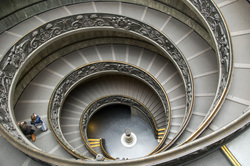 The Spiral Stairway at the Vatican Museum Did Pope Joan really exist or is she a work of medieval fiction? Although this is supposed to have happened over eleven hundred years ago the sequence of popes was well documented, and not just their succession, but also their abhorrent behaviour. This was a time when political intrigue ruled. There was backbiting, slurring, and in 897 Pope Stephen VII had the rotting corpse of his predecessor, Pope Formosus, dug up and put on trial. And as much as the church might want to bury these details, they can’t. Not only is it recorded in the papal archives, but it’s also a matter of public record, everyone knew. So what do the records say about Pope Joan? Historians seem to agree that records were altered, but not before the thirteenth century when her story came to light, and it seems that they were altered to add her to the record, not delete her.
The Spiral Stairway at the Vatican Museum Did Pope Joan really exist or is she a work of medieval fiction? Although this is supposed to have happened over eleven hundred years ago the sequence of popes was well documented, and not just their succession, but also their abhorrent behaviour. This was a time when political intrigue ruled. There was backbiting, slurring, and in 897 Pope Stephen VII had the rotting corpse of his predecessor, Pope Formosus, dug up and put on trial. And as much as the church might want to bury these details, they can’t. Not only is it recorded in the papal archives, but it’s also a matter of public record, everyone knew. So what do the records say about Pope Joan? Historians seem to agree that records were altered, but not before the thirteenth century when her story came to light, and it seems that they were altered to add her to the record, not delete her.
What about the date 855AD? This comes back to those papal records. Pope Leo IV died on 17th July 855 and Pope Benedict III was consecrated as his successor on 29th September. Did Pope Joan reign sometime in this two-month gap? Unfortunately, no. A man named Anastasius made a grab for power, imposing himself onto the papacy. Known as the antipope, he was, by all accounts, an odious man, who imprisoned his rival, Benedict, in an attempt to gain control. But he was unable to stay in office without the support of the nobles and people, thus Benedict became pope on 29th September. Anastasius is still on record as papal librarian in 872 AD. So he wasn’t executed by the crowd after giving birth. I also think that a man like Anastasius would’ve had enemies and if they could have unmasked him as a woman they would have.
There are many more arguments for and against, but I suppose I always come back to the common sense approach, which leaves me feeling that this is a work of medieval fiction, mainly because if a woman disguised herself as a priest someone would’ve noticed. And how could she conceal herself for any length of time? It would have taken her years to become a cardinal. Plus, bishops and cardinals, especially in the ninth century had servants, and servants see things. You’d think someone would’ve noticed that her beard didn’t grow and she didn’t have an Adam’s apple.
The whole thing feels very much like a medieval warning to women, especially the grizzly end. A woman who was smart and calculating enough to disguise herself for years, and become pope, would be intelligent enough to avoid pregnancy. But medieval scholars believed that women were driven by a need for sex and where unable to contain their primal urges. So to them Pope Joan’s horrific end was inevitable.
I think the story has stayed alive because it has appealed to different people at different times in history. There have even been two movies made about her. The account was widely used in the reformation to discredit the papacy and more recently has been used to justify female priests. Personally I have no problem in believing that a woman could fulfill the role of pope, I just don’t know that it has happened in the past.
Here is a short two-minute video by CNN on the subject.
 A Woodcut of Pope Joan giving birth Pope Joan reigned around 855 AD as Pope John VIII. Some say she reigned for two weeks others say two years. When told as a twelve year old that she would be unable to continue her studies as a woman, she disguised herself as a monk, travelled with her tutor, to Greece where she continued her education. From there, accompanied by her lover, she went to Rome where she became a clerk in the Vatican. Her rise seems to have been meteoric; she was promoted to cardinal, and was elected pope in 855 AD. Unfortunately she became pregnant and gave birth to her child during in a public procession. The crowd on learning that the pope was a woman executed her immediately, some say she was stoned and others say she was dragged by a horse. Apparently there is a street that popes avoid known as the Vicus Papissa or the street of the female pope.
A Woodcut of Pope Joan giving birth Pope Joan reigned around 855 AD as Pope John VIII. Some say she reigned for two weeks others say two years. When told as a twelve year old that she would be unable to continue her studies as a woman, she disguised herself as a monk, travelled with her tutor, to Greece where she continued her education. From there, accompanied by her lover, she went to Rome where she became a clerk in the Vatican. Her rise seems to have been meteoric; she was promoted to cardinal, and was elected pope in 855 AD. Unfortunately she became pregnant and gave birth to her child during in a public procession. The crowd on learning that the pope was a woman executed her immediately, some say she was stoned and others say she was dragged by a horse. Apparently there is a street that popes avoid known as the Vicus Papissa or the street of the female pope. The Spiral Stairway at the Vatican Museum Did Pope Joan really exist or is she a work of medieval fiction? Although this is supposed to have happened over eleven hundred years ago the sequence of popes was well documented, and not just their succession, but also their abhorrent behaviour. This was a time when political intrigue ruled. There was backbiting, slurring, and in 897 Pope Stephen VII had the rotting corpse of his predecessor, Pope Formosus, dug up and put on trial. And as much as the church might want to bury these details, they can’t. Not only is it recorded in the papal archives, but it’s also a matter of public record, everyone knew. So what do the records say about Pope Joan? Historians seem to agree that records were altered, but not before the thirteenth century when her story came to light, and it seems that they were altered to add her to the record, not delete her.
The Spiral Stairway at the Vatican Museum Did Pope Joan really exist or is she a work of medieval fiction? Although this is supposed to have happened over eleven hundred years ago the sequence of popes was well documented, and not just their succession, but also their abhorrent behaviour. This was a time when political intrigue ruled. There was backbiting, slurring, and in 897 Pope Stephen VII had the rotting corpse of his predecessor, Pope Formosus, dug up and put on trial. And as much as the church might want to bury these details, they can’t. Not only is it recorded in the papal archives, but it’s also a matter of public record, everyone knew. So what do the records say about Pope Joan? Historians seem to agree that records were altered, but not before the thirteenth century when her story came to light, and it seems that they were altered to add her to the record, not delete her.What about the date 855AD? This comes back to those papal records. Pope Leo IV died on 17th July 855 and Pope Benedict III was consecrated as his successor on 29th September. Did Pope Joan reign sometime in this two-month gap? Unfortunately, no. A man named Anastasius made a grab for power, imposing himself onto the papacy. Known as the antipope, he was, by all accounts, an odious man, who imprisoned his rival, Benedict, in an attempt to gain control. But he was unable to stay in office without the support of the nobles and people, thus Benedict became pope on 29th September. Anastasius is still on record as papal librarian in 872 AD. So he wasn’t executed by the crowd after giving birth. I also think that a man like Anastasius would’ve had enemies and if they could have unmasked him as a woman they would have.
There are many more arguments for and against, but I suppose I always come back to the common sense approach, which leaves me feeling that this is a work of medieval fiction, mainly because if a woman disguised herself as a priest someone would’ve noticed. And how could she conceal herself for any length of time? It would have taken her years to become a cardinal. Plus, bishops and cardinals, especially in the ninth century had servants, and servants see things. You’d think someone would’ve noticed that her beard didn’t grow and she didn’t have an Adam’s apple.
The whole thing feels very much like a medieval warning to women, especially the grizzly end. A woman who was smart and calculating enough to disguise herself for years, and become pope, would be intelligent enough to avoid pregnancy. But medieval scholars believed that women were driven by a need for sex and where unable to contain their primal urges. So to them Pope Joan’s horrific end was inevitable.
I think the story has stayed alive because it has appealed to different people at different times in history. There have even been two movies made about her. The account was widely used in the reformation to discredit the papacy and more recently has been used to justify female priests. Personally I have no problem in believing that a woman could fulfill the role of pope, I just don’t know that it has happened in the past.
Here is a short two-minute video by CNN on the subject.
Published on March 22, 2014 05:35



